Do you still see animal shapes in clouds? If so, you’ll enjoy doing the same with the Moon, home to the Moon Maiden, a giant pair of scissors, and other fantastic specters of light and shadow.
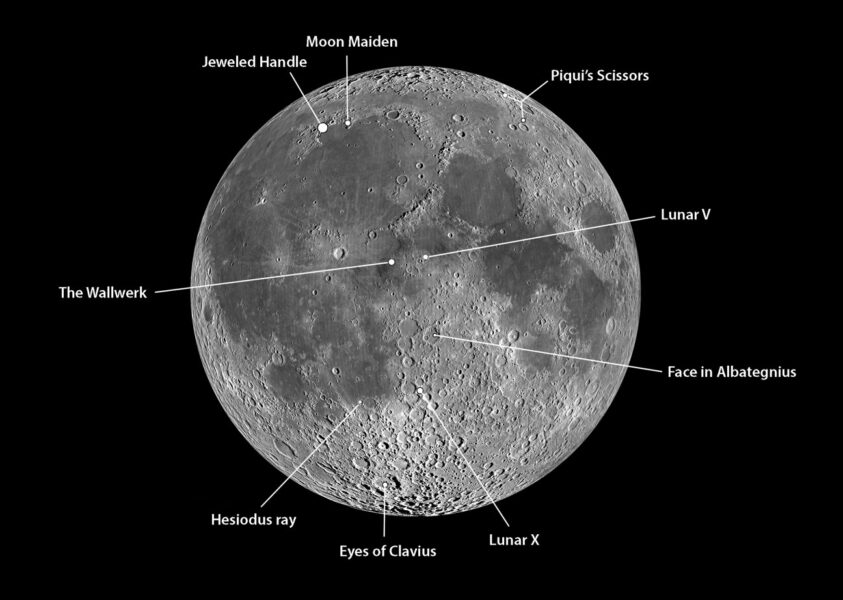
NASA / GSFC / Arizona State University photo with annotations by Bob King
Pareidolia — our ability to see patterns in randomness — can sometimes mislead us. You'll recall the Face on Mars photographed by NASA's Viking 1 spacecraft from orbit. Limited-resolution images showed a human visage on a hilltop that some interpreted as evidence of a long-lost Martian civilization. Later photos taken with better cameras clearly revealed that the "face" was nothing more than the play of light and shadow on an eroded mesa.
The sunnier side of pattern-seeking is the simple joy of watching faces and animal forms emerge from billowy clouds on a summer afternoon. Human pareidolia populated the night sky with constellations and continues to enlighten through art. One of my favorite places to find familiarity in randomness is the Moon. The continuous interplay of sunlight and shadow through its changing phases provides a myriad of opportunities to see faces, eyes, cities, alphabet letters — almost anything you might imagine. Lunar enthusiasts call them clair-obscur effects, derived from the French words for "light" and "shadow."
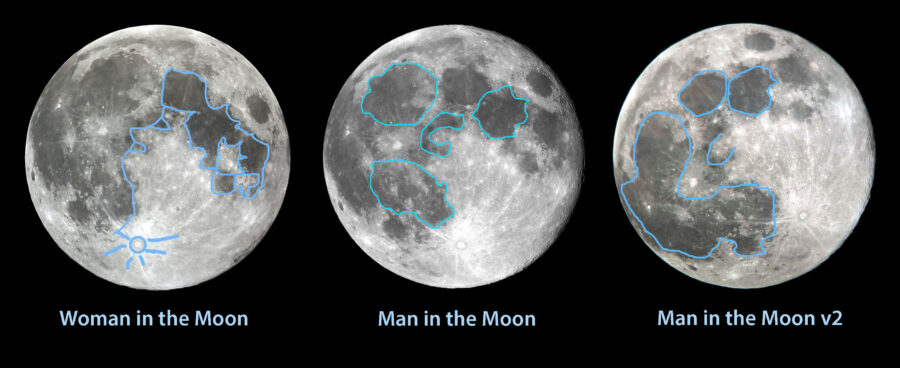
Bob King (left, right) and Luc Viatour, CC BY-SA 3.0 (center)
For many of us, our first introduction to astronomical pareidolia (pair-eye-DOL-yuh) began with the proverbial Man in the Moon, fashioned from eye-like maria and patches of bright highlands. I still look up and see that face every full Moon. Others see a rabbit or the Woman in the Moon, also one of my favorites. All three patterns illustrated above take up the entire lunar nearside, but there are many more smaller-scale patterns visible in binoculars and telescopes collectively known as lunarisms.
Lunar ABCs
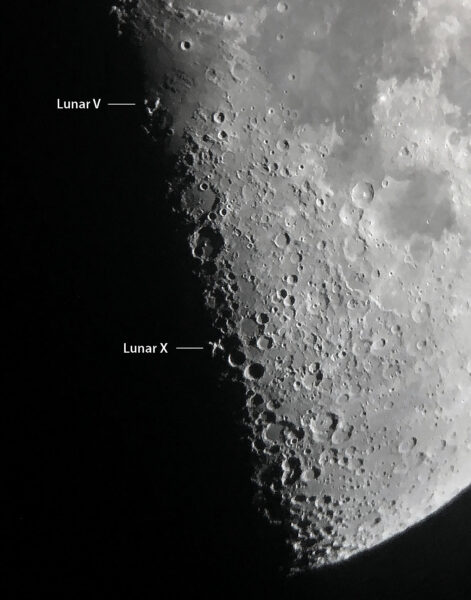
Bob King
Probably the best known are the Lunar X and Lunar V, both of which are visible at first-quarter Moon. The X appears when sunlight skims the rims of the adjoining craters Blanchinus, Le Caille, and Purbach at the same time their interiors are still steeped in shadow. It's also known as Werner X (after a nearby crater) or The Purbach Cross. Farther north along the terminator look for the Lunar V at the same time. Slanted sunlight highlights two converging ridges of Mare Imbrium ejecta and the eroded rims of the craters Ukert M and N located just east of Ukert. To me it's an extraterrestrial version of the famous Spock salute "live long and prosper."
Both are visible for about four hours until the rising Sun begins to fill in the area around them. The next best opportunities for U.S. observers to see the alphabetic pair follow. All times are UT. To convert to EDT, subtract 4 hours; 5 hours for CDT; 6 hours for MDT; and 7 hours for PDT):
May 27th (starting around 7:00 UT); July 25th (5:00 UT); September 22nd (4:00 UT) and November 20th (5:00 UT).
Lurking faces, peering eyes

NASA's Scientific Visualization Studio (SVS)
During the same lunar phase you can also look for the Face in Albategnius, a 129-kilometer-wide crater located approximately midway between the Lunar X and Lunar V. At the start of the Lunar X apparition, the eastern wall of Albategnius casts a shadowy profile of a face with a full head of hair, very believable nose, and jutting chin. Two hours later that face disappears to be replaced by one with a different profile and pointier nose.
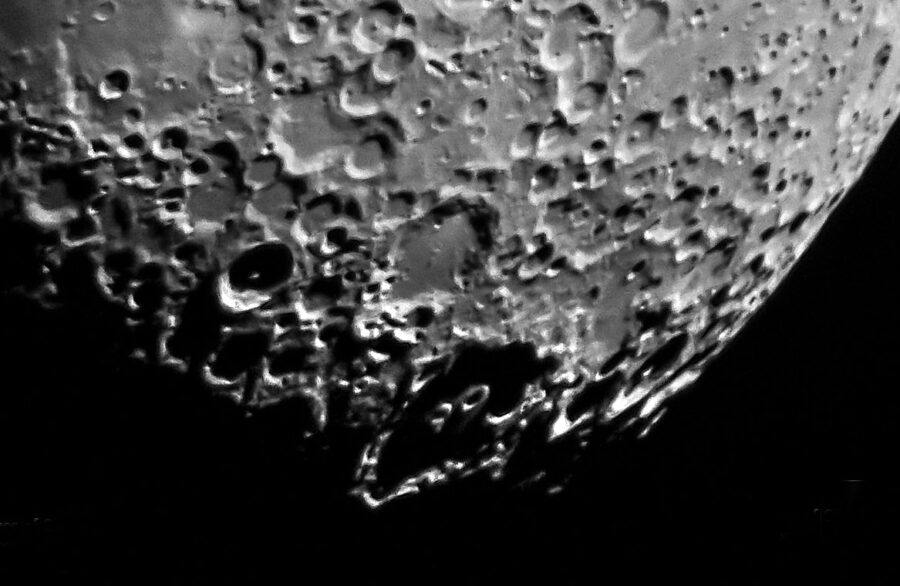
Mary McIntyre
Have you ever stared into the Eyes of Clavius? With a diameter of 225 kilometers (140 miles) Clavius is the second-largest crater visible on the lunar nearside. It's so big that it encloses numerous satellite craters including the prominent quartet of Clavius D, C, N, and J. When the Sun first peeps over the terminator of the 8-to-9-day-old waxing gibbous Moon, it delicately illuminates the rims of the two largest, Clavius D and C, transforming them into a pair of eyes peeping from the crater's abysmal depths. Here again are some U.S. viewing times (CDT) courtesy of Mary McIntyre, an Oxfordshire-based (England) amateur astronomer, astrophotographer, and Moon enthusiast.
April 29th starting at 4:00 UT
June 27th starting at 8:00 UT (Western U.S. only)
August 25th starting at 6:00 UT
October 23rd starting at 2:00 UT
December 21st starting at 1:00 UT
Like a ray of sunshine
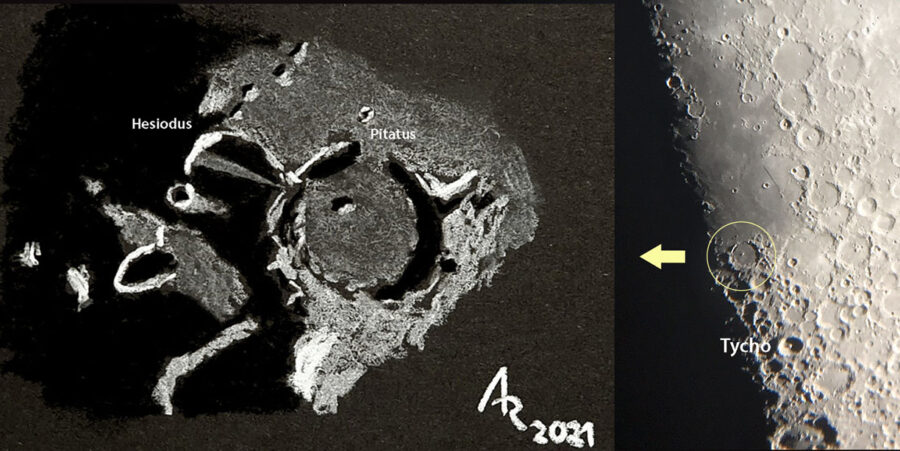
Achim Rohe, Right: Bob King
A number of craters have narrow gaps or slumps in their walls that allow the light of the rising or setting Sun to beam into their dark, pre-sunrise interiors. One of the best known is Hesiodus (43 km). When the Moon is eight days old, a sunrise ray passes through a breach in the crater's wall and fans across the shadowed floor like an open door lets light into a darkened room. The sight is brief, lasting a couple of hours at most, but it's both dramatic and a great way to experience a lunar sunrise. For precise times, head over to the Robinson Lunar Observatory site and consult this table of sunrise-ray times, good through the year 2029. If Hesiodus whets your appetite for more, the site has predictions for 81 additional craters.
Now where did I leave those scissors?
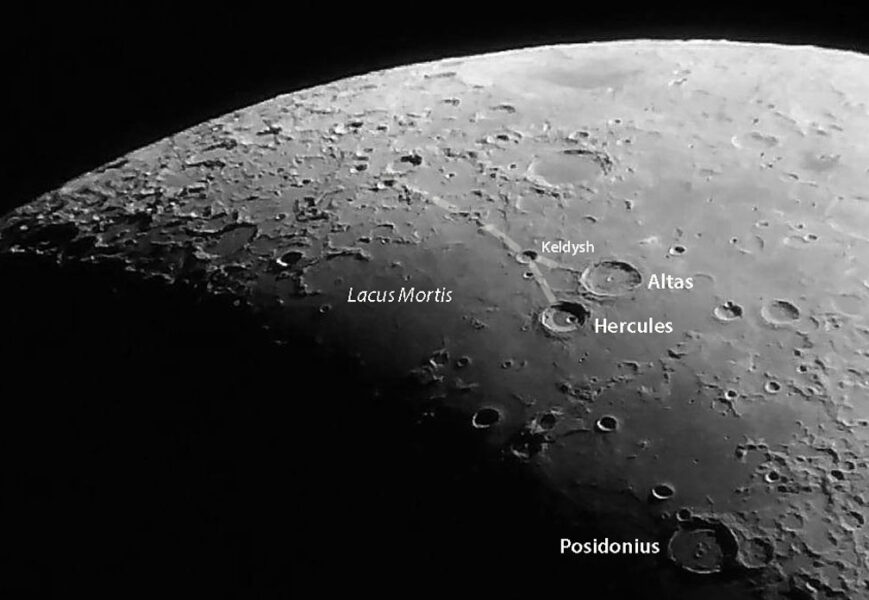
Piqui Diaz
That's right. Almost forgot — there's a pair on the Moon! Amateur astronomer Piqui Diaz of Ezeiza, Argentina, wrote me recently about a clair-obscur effect that caught her eye while observing the Moon with her 90-mm refractor, a feature she dubs Piqui's Scissors. It's a remarkably realistic-looking pair of closed scissors visible near the terminator when the Moon is five or six days old. The paired craters Atlas and Hercules form the finger holes with Keldysh at the blades' pivot point. A string of hilly terrain extends in a broken line to the north and traces the tool's closed blades. See it yourself the nights of April 24th and 25th; May 23rd and 24th; and June 22nd and 23rd.
City of dreams
When it comes to a vivid imagination, it's hard to top the 19th-century Bavarian physician and astronomer Franz von Gruithuisen. Like a number of other scientists at the time he thought the Moon was inhabited, a mindset that helped his eyes to transform a series of random ridges north of the crater Schröter into a gigantic lunar city.
"At first sight of this object," he wrote, "I fancied I was looking down from the height of a steep mountain, through the seething ocean of air, and had the bird's-eye perception of a city before me." He named it the Wallwerk.
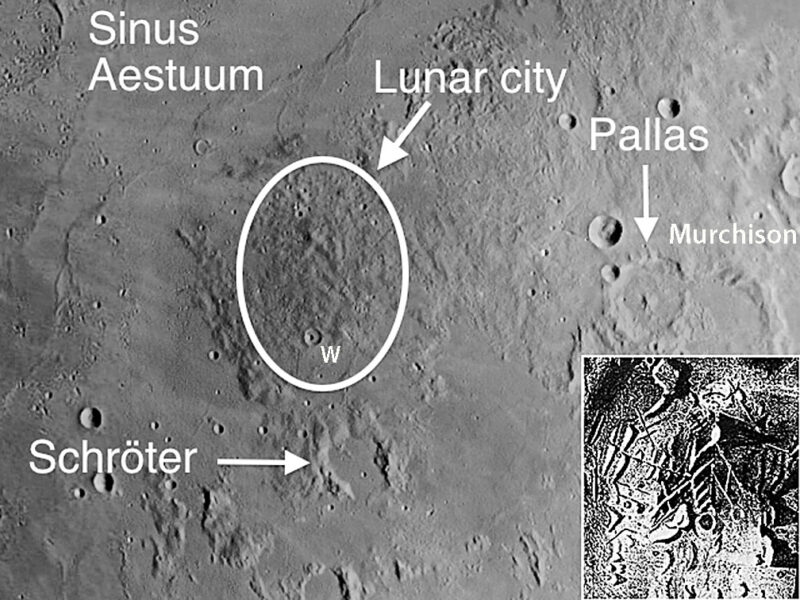
Courtesy of Andrew Planck. Inset: 1822 sketch by Franz von Gruithuisen
It's worth noting that seeing was poor at the time of his observation on July 12, 1822. Visual observers are well-acquainted with the vagaries of unsteady air and its ability to blur detail and drive the imagination to make much of little. I can't tell you how many suspect comets I've seen that turned out to be closely spaced faint stars.
Measuring about 60 × 45 kilometers in length and breadth, Wallwerk is located about a third of the way from the overlapping craters Pallas and Murchison and the prominent bowl of Erastothenes, located at the western terminus of the Apennine Mountains. A drawing Gruithuisen made in October 1822 shows a crisp herringbone pattern of walls branching out at 45° and 90° angles from a prominent central structure running due north-south. He likened the city's appearance to "the veins of an alder- or a rose-leaf."
To tour the once-upon-a-time city use medium to high magnification on this region when it's on or near the terminator. Gruithuisen observed it during the last-quarter Moon around lunar sunset, but I've heard of others also seeing it around first quarter. U.S. observers should stop by when the Moon is either eight or 23 days old on the following dates: March 29th (evening-early morning), May 13th (morning), May 27th (evening) and July 11th (morning). Like the Hesiodus Ray, the "city" looks best and shows great detail at higher magnifications above 150x.
Bejeweled bottle opener?
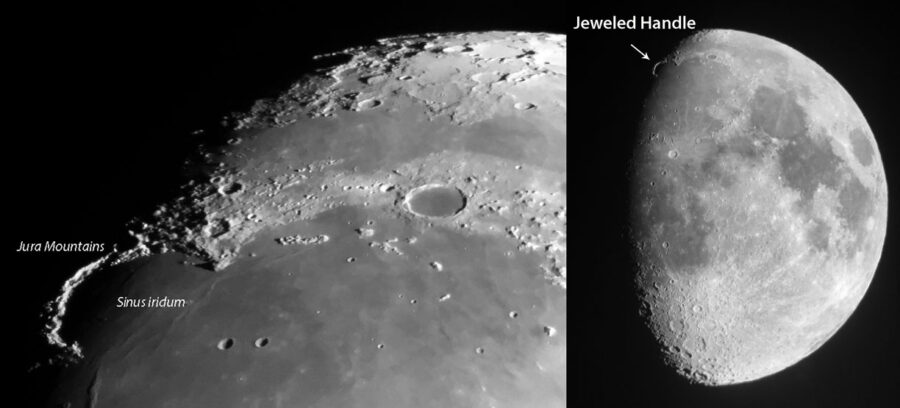
Bob King
While it reminds me a little of an old bottle opener, the beautiful arc of the Jura Mountains is one of the most amazing sights anywhere on the Moon. Better known as the Jeweled or Golden Handle, it's best visible when the Moon's age is 10 days. You'll have no problem spotting it in binoculars. I've even seen it with the naked eye and averted vision as a tiny fragment of light extending beyond the terminator. The contrast between the brilliance of the arc and Sinus Iridum, still swathed in darkness, is absolutely mesmerizing, especially when viewed in a telescope.
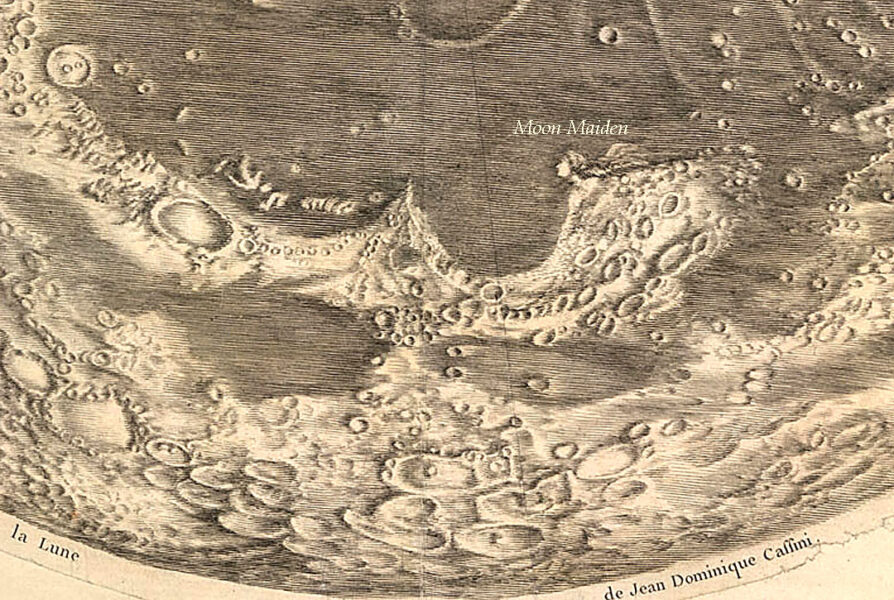
Giovanni Cassini
Our final selection is Italian astronomer Giovanni Cassini's Moon Maiden, which may be one of the earliest recordings of a small-scale lunarism. The feature appears in his 1679 map of the Moon and depicts the profile of a woman with flowing hair at the location of what is now Promontorium Heraclides at the western end of the Jura Mountains overlooking Sinus Iridum. Just as the low-resolution photo of the Face on Mars made it easy to imagine a human face, below-average atmospheric seeing makes the Moon Maiden even more convincing. On nights of rock-steady air, the illusion is lost.
When observing lunarisms keep in mind that the times we see them best each month vary somewhat because of libration, the cyclic nodding and wobbling of the Moon caused by its tilted axis and variable orbital speed. Moreover, Moon phases repeat every 29.5 days, not every month. For example, if the lighting was just right to see the Eyes of Clavius one month, it won't be the next because the Moon will either be up in the daytime sky or not yet risen for your location during near-identical lighting conditions. Chances are excellent however for a repeat the following month. That's why I've included links to tables so you can see check on optimum times.
Or you can do it yourself manually by using the Dial-A-Moon feature on NASA's Scientific Visualization Studio (SVS) page. Just type in the UT time when you plan to observe and press the blue GO button for a basic image of the Moon at that time. For a more detailed (and fully labeled) view, click the gray Download button, save and then open the file. You can also download and use the Lunar Terminator Visualization Tool (LTVT) to make detailed to-the-minute predictions. Here are some additional resources to check out:
- Mike Rowles' delightful list of 99 lunarisms
- Mary McIntyre's current visibility tables for popular clair-obscur effects
- Clair-obscur list on Wikipedia
- GlobeViewer Moon app (Android) or Moon Globe (iPhone) to check Moon phases and identify lunar features
- Virtual Moon Atlas for planning lunar observing sessions
 7
7









Comments
Anthony Barreiro
March 29, 2023 at 7:53 pm
Thanks Bob. Some years ago the waxing gibbous Moon was making a very close conjunction to Jupiter in the evening. I set up 15x70 binoculars on the sidewalk in front of my home to show passersby the view. One guy asked me why there was a wire hanging off the edge of the Moon. I had to look through the binoculars to figure out what he was referring to. The Jura Mountains were lit up by sunrise while western Sinus Iridum was still in shadow. Eventually I was able to explain to him what was going on, using the analogy of seeing distant mountains lit up by sunrise here on Earth before the Sun has risen down in the valley. Suddenly considering the Moon as a three-dimensional body blew his mind.
You must be logged in to post a comment.
Bob KingPost Author
March 31, 2023 at 12:16 am
Hi Anthony,
I can appreciate that revelation. What a pleasure it must have been for you as well — to know you helped him see the Moon in a way he'd never considered before. Reality is powerful.
You must be logged in to post a comment.
Anthony Barreiro
March 31, 2023 at 8:00 pm
Yes, it was a special moment. I love sidewalk astronomy, especially those occasions when you can help somebody see the universe in a new way. Covid completely shut me down, but recently I've started putting my toe back in the water.
You must be logged in to post a comment.
PGT
March 30, 2023 at 7:32 am
Don't forget an old version "man in the moon" who has a bundle of sticks, a lantern and a dog: Mare Serenitatis is his head; Mare Nectaris and Mare Fecunditatis are his legs. For a sketch, see https://en.wikipedia.org/wiki/Man_in_the_Moon
You must be logged in to post a comment.
Bob KingPost Author
March 31, 2023 at 12:14 am
Hi PGT,
Thanks for writing and the visual link. While I didn't include an image I did mention him in the caption as the woodcutter.
You must be logged in to post a comment.
Eric Stricko
April 3, 2023 at 11:26 am
As luck would have it, the first-light image I saw with my new 8" SCT revealed the Lunar X and the Lunar Y. I'm grateful for columnists like you from whom my familiarity with lunar asterisms grew!
You must be logged in to post a comment.
Bob KingPost Author
April 3, 2023 at 12:01 pm
Hi Eric,
A fine way to christen your new instrument! Thanks and I'm glad you spotted them. I will share more soon!
You must be logged in to post a comment.
You must be logged in to post a comment.